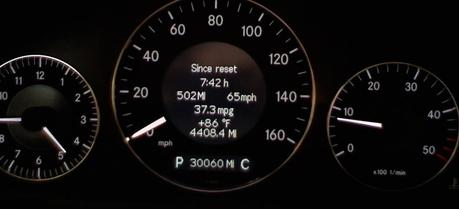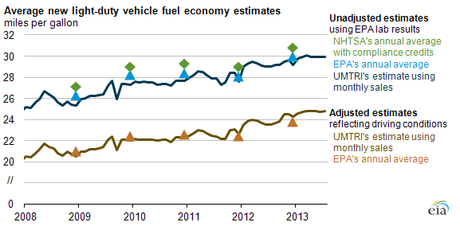 (Credit: Flickr @ TatClarkson http://www.flickr.com/photos/generativecontent/)
(Credit: Flickr @ TatClarkson http://www.flickr.com/photos/generativecontent/)
Since the Arab oil embargo of 1973-74, U.S. government agencies and research institutes have published fuel economy statistics for new light-duty vehicles. Light-duty vehicles include all passenger and other vehicles with a gross weight of 8,500 pounds or less. New-vehicle fuel economy has more than doubled since the 1970s. Moreover, new-vehicle fuel economy is projected to continue to increase by more than 50% by 2040, according to EIA’s most recent Annual Energy Outlook.
Fuel economy statistics

EPA and NHTSA estimates reflect model years, while UMTRI estimates reflect calendar years. (Source: U.S. Energy Information Administration, based on the Environmental Protection Agency (EPA), National Highway Transportation Safety Administration (NHTSA), and University of Michigan Transportation Research Institute (UMTRI))
The Environmental Protection Agency (EPA) and the National Highway Transportation Safety Administration (NHTSA) both provide annual fuel economy estimates. EPA, responsible for administering the Corporate Average Fuel Economy (CAFE) program, publishes laboratory test results for each make and model. NHTSA, responsible for monitoring CAFE compliance, issues fuel economy credits for qualified vehicles. NHTSA fuel economy calculations are higher than EPA’s test results for some vehicles because they take into account the fuel economy credits issued.
EPA’s annual publication on light-duty vehicles includes fuel economy data by vehicle category (passenger vehicle and other light-duty vehicles), vehicle type (cars, wagons, nontruck SUVs, vans, truck SUVs and pickups), and size (small, midsize, and large).
The report presents both adjusted and unadjusted city, highway, and average fuel economy statistics. The unadjusted estimates are EPA laboratory test results. The adjusted estimates are about 20% lower than the unadjusted estimates and are based on EPA models. These adjustments are intended to reflect actual driving conditions, such as high speeds, aggressive accelerations and decelerations, air conditioner use, cold weather, and varying road conditions.
For each model year, NHTSA publishes average fuel economy data for each make and model of light-duty vehicle. The NHTSA data are published about one year after the publication of EPA’s annual report.
The University of Michigan Transportation Research Institute (UMTRI) produces monthly sales-weighted fuel economy data derived from fuel economy ratings from EPA combined with monthly sales data from vehicle manufacturers.
CAFE compliance and fuel economy credits
For CAFE compliance purposes, NHTSA issues fuel economy credits to qualified vehicles to promote the use of alternative fuels. The largest classification of such vehicles is flex-fuel vehicles, which accounted for one-seventh of 2010 model-year light-duty vehicles. For these vehicles, the NHTSA fuel economy values, including credits, were 1.654 times the EPA motor gasoline-based values. For example, a 2010 Chrysler Avenger Flex-Fuel Vehicle with an EPA motor gasoline-based test value of about 29 miles per gallon (mpg) was considered to have a fuel economy rating of almost 48 mpg for CAFE compliance purposes.
Other qualified vehicles are non-hybrid natural gas and electric vehicles, for which the NHTSA fuel economy values are 6.667 times the EPA motor gasoline-based values. A 2010 Honda Civic powered exclusively by natural gas with an EPA motor gasoline-based test value of around 37 mpg is assumed to have a fuel economy rating of about 250 mpg for CAFE compliance purposes. The amount of NHTSA credits for qualified vehicles for each manufacturer or importer is capped at the equivalent of 1.2 mpg times the number of vehicles manufactured.
Most manufacturers, even those that do not receive credits for qualified alternative fuel vehicles, have consistently met or exceeded the CAFE compliance thresholds. Some manufacturers, however, do not meet CAFE standards and several (e.g., Lamborghini and Rolls Royce) are even required to pay “gas guzzler” taxes for producing vehicles with very low fuel economy.
Principal contributor to the original article: Michael Morris.

